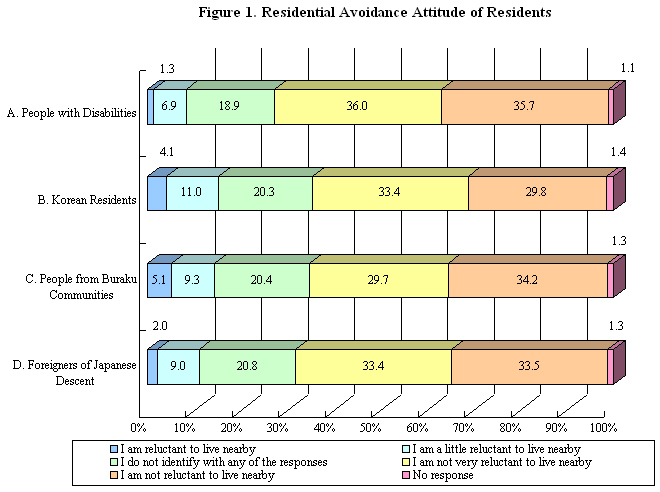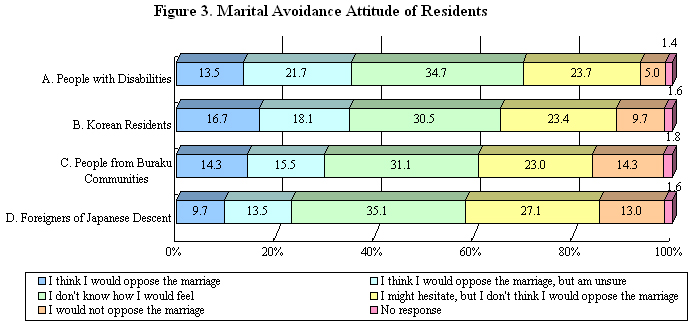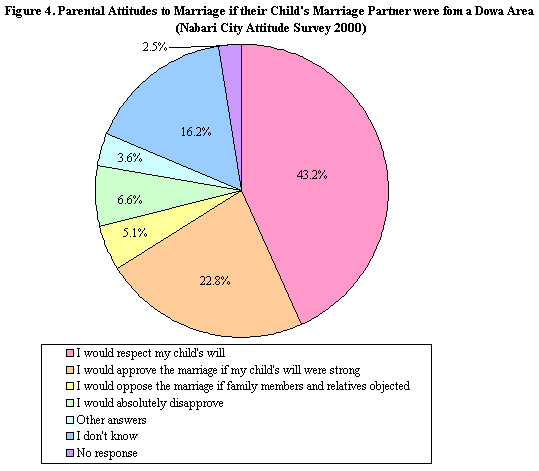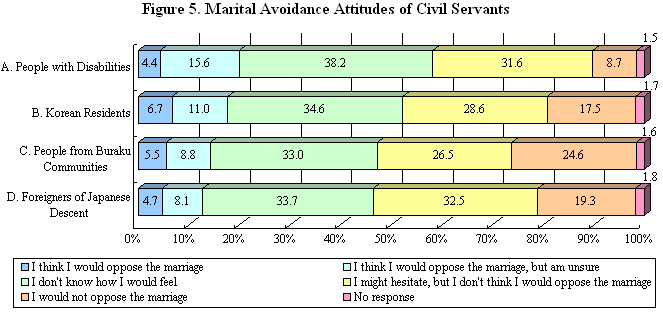2nd Quarterly, 2005 No.136
2004 Nabari City Survey Concerning Human Rights.
<part I>
Nabari City conducted three surveys to look into the background of and challenges concerning various human rights issues faced by the city, including the Dowa problem. In collaboration with the Buraku Liberation and Human Rights Research Institute, Nabari City analyzed the results and prepared a leaflet to educate its citizens about human rights problems within their city as one of the efforts to foster a discrimination-free society.
Outlines of the Surveys:
- Nabari citizens attitude survey: This survey targeted citizens who were aged over 16 as of August 1, 2004. The survey was sent out in September to 3,000 people who were selected by random sampling. The effective response rate was 50.9%.
- City employees attitude survey: This survey was sent to 1,330 people who were registered as being city employees (including part-time and seasonal staff) as of October 1, 2004. It was conducted in October 2004, and the effective response rate was 75.7%.
- Survey to identify the actual living conditions and attitude of non-Japanese residents of Nabari City: This survey was posted to 521 non-Japanese people who were residents of the city and aged over 16 as of 2004. There were 94 effective responses with an effective collection rate of 19.8%.
| Nabari City is in Mie Prefecture. It has the population of 83,010 and 28,607 households as of October 1, 2005. The city is situated near Nara Prefecture, and is a one- hour train-ride from downtown Osaka. |
Avoidance Attitudes
(from the Attitude Surveys of Residents and Civil Servants)
No person is safe from human rights violation. However, human rights violations are not evenly experienced by every person. People belonging to minority groups are more vulnerable to human rights infringements in forms such as discrimination.
To better understand such phenomena, the Attitude Surveys of Citizens and City Employees questioned residents and civil servants about their attitudes towards (a) people with disabilities, (b) Korean residents, (c) people from Buraku communities, and (d) foreigners of Japanese descent, as minority groups that are more exposed to human rights violations. The intent of the surveys is to paint a clear picture of the extent to which minority group members are exposed to discrimination by recognizing the attitudes of people who could discriminate against them by avoidance (the "avoidance attitude").
The surveys employ two means of measuring avoidance attitudes. One measures attitudes concerning close residential proximity to minority communities ("residential avoidance"), and the other measures attitudes concerning hypothetical marriage between respondents' children and the child of a minority group member ("marital avoidance").
Residential Avoidance
Figure 1 shows the attitudes of respondents with regard to living close to minority groups. According to the survey, 60% to 70% of respondents are either not reluctant or not very reluctant to live near any of the minority groups mentioned. The proportion of people who answered that they are either reluctant or a little reluctant is relatively small. Similarly, to the questions regarding living near Korean residents and people with Buraku backgrounds, only around 15% of the respondents answered that they are either reluctant or a little reluctant to do so.

Figure 2 shows the residential avoidance attitudes of city employees. In comparison with Figure 1, fewer people display residential avoidance attitudes. Between 70% and 80% of respondents answered that they are either not reluctant or not very reluctant to live near any of the minority groups mentioned in the survey. The percentage of people who answered they are either reluctant or a little reluctant to do so is between 7% and 11%.

Marital Avoidance
Figure 3 shows residents' attitudes regarding marriage with minority group members. In comparison with residential avoidance, the proportion of respondents who answered they think they would oppose the marriage, or think they would oppose it but are unsure, is larger. The percentage of people who think they would oppose the marriage, regardless of whether or not they would hesitate, amount to nearly 30% or more for every group except foreigners of Japanese descent. This means that three in ten minority group members are likely to encounter marriage discrimination. This data attests to the severity of marriage related discrimination.

Figure 4 represents an Attitude Survey conducted by Nabari City in FY 2000 and shows the attitudes of parents towards marriage if their child's marriage partner were from a Dowa area. Although differing response types makes it difficult to closely compare this survey with the one mentioned above, there seems to be no significant difference in attitudes.

Figure 5 shows the marital avoidance attitudes of city exmployees. Compared with residential avoidance, the percentage of people who answered they either think they would oppose the marriage, or think they would oppose it but are unsure, is larger (from 8% to 16% for every group). While the marital avoidance attitude of civil servants is milder than that of residents, it is remarkable that the percentage of those who said they don't know how they would feel is as high as 30% to 40%.

Figure 6 shows further examination of attitudes toward marriage with people from Buraku communities, focusing on the difference in attitudes by age group. In the group aged under 30, the percentage of respondents who would not oppose the marriage exceeds 30%. The avoidance attitude decreases with age. However, the percentage of people who either think they would oppose the marriage, or think they would oppose the marriage but are unsure, is more than 30% for the group aged over 50. It is conceivable that the children of this group are now at marrying age. Taking this figure into account, it is unfortunately highly likely that marriage discrimination is continuing to occur.

